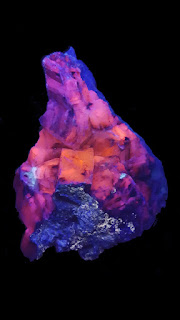Fluorescent and phosphorescent tremolite (white-blue) with "eyes" of an unidentified green fluorescent mineral outlined in white-blue. 6"x3.5"x1" (Maricopa County)
Same, white light.
Close-up of the green "eyes".
Fluorescent white-blue tremolite rosettes on a freshly split face. 4"x2.5"x1"
Same specimen, white light. Rosettes this large were not easy to find.
Smaller tremolite rosettes with orange and yellow fluorescent caliche. 5"x5"x2"
This piece was weathered on the surface, allowing the secondary caliche to form.





































